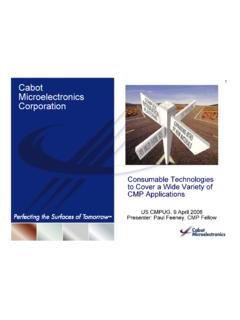Transcription of Roll to Roll Processing for Flexible Electronics
1 roll to roll Processing for Flexible Electronics by Evan Schwartz Cornell University MSE 542: Flexible Electronics Prof. Chris Ober May 11, 2006 Abstract: This review discusses the current state-of-the-art technology behind the developing field of roll -to- roll - Processing for Flexible Electronics . The aim is to present a realistic view of the technical obstacles still to be overcome in this field and entertain different ideas on how to achieve them. The need for new substrate materials, innovative patterning methods and impermeable barrier layers are presented in as much detail as possible. Industry perspectives on the cost and product development requirements are also discussed. Introduction It doesn t take a large stretch of the imagination to realize that Electronics are everywhere. From calculators to laptop computers, we have become accustomed to electronic devices that get more portable every year due to advances in circuit, chip and battery design. The workhorse behind the technology is a technique called photolithography, which, since its invention in 1959, has shrunk the size of printed circuit features 400 fold.
2 28 However, lithography is expensive because, at high resolution, it can only pattern small areas at a time. The Electronics industry is now looking to fabricate structures on a larger scale, and would prefer to use Flexible substrates that would have a lower profile, lighter weight and be more rugged than Silicon substrates. Their use would also offer manufacturers the potential for continuous, high throughput printing on large rolls (often called a web ) rather than batch Processing small 12 wafers. Together, with the rise of organic Electronics , roll to roll (R2R) Processing could revolutionize large area Electronics manufacturing and could be used to mass produce photovoltaic roofing panels, large area solid state lighting devices, x ray imagers and Flexible flat panel displays. The Flexible display market is expected to grow from $5 million in 2006 to $339 million in 2013, or percent per year, according to market research firm iSuppli Corp. 7 Despite the attractiveness of Flexible Electronics , this new technology must overcome significant technical and process challenges in order to gain practical, high 2volume applications.
3 Chief among these challenges are those that relate to the cost and performance of Flexible circuits, panel size, process throughput, substrate distortion, barrier layer technology and yield. This paper aims to elucidate the requirements necessary for the adoption of this new technology into mainstream manufacturing and discuss the enabling technologies behind the R2R process flow: Flexible substrate materials, novel patterning techniques, and robust barrier layer packaging. Figure 1. roll to roll manufacturing process flow. Adapted from ref. 24. A Typical R2R Process Flow Before moving into industrial level requirements for the adoption of R2R Processing , it will be helpful to describe and define the elements of a typical process flow for a typical Flexible Electronics process, namely, the creation of a thin film transistor. As shown in Figure 1, the three essential steps of R2R manufacturing are deposition, patterning and packaging. Following the bottom contact TFT device structure shown in Figure 2, a transparent conducting oxide film is deposited on top of the Flexible substrate to act as the gate electrode for the TFT.
4 Indium Tin Oxide (ITO) is the current industry favorite due to its superior environmental stability, low electrical Step 1 Step 2 Step 3 Raw Materials Finished ProductDepositionPatterningPackaging 3resistivity (1 to 3 x 10 4 cm) and high transparency to visible light (>90% at a film thickness of 100 nm). 17 In the interest of space, deposition methods will not be discussed in this review. In subsequent patterning steps, a thin insulating dielectric film of SiO2 and the metallic source and drain electrodes are produced before printing the organic semiconductor layer. Rather than conventional photolithography methods, soft lithography methods, laser ablation, and inkjet printing methods seem like promising technologies for large area Flexible displays. Finally, the devices must be packaged in a barrier layer to prevent oxygen and moisture contamination of the organic semiconductor layers. InsulatorSourceDrainDrainSourceOrganic Semiconductor Layer Gate Substrate Figure 2. Schematic device structure of a bottom contact organic thin film transistor.
5 4 Figure 3. Photograph of an OLED display. Courtesy of Substrate Materials The lack of a clear choice for substrate material is inhibiting the development of Flexible displays. The ideal substrate would be transparent (for OLED emissive displays), Flexible and rollable, low cost, resistant to chemical attack, dimensionally stable under thermal cycling and would have low permeability to water and oxygen and thus able to act as an intrinsic barrier layer. If this barrier layer were inherent in the substrate, simply laminating two film sheets together would be sufficient to package the device at low cost. No material has emerged that fills all of these needs (see Table 1), but the three that have come close are glass, plastic and stainless steel. 5 Property Stainless Steel Plastics (PEN, PI) Glass Thickness ( m) 100 100 100 Weight (g/m2) 800 120 220 Safe bending radius (cm)4 4 40 RTR processable? Yes Likely Unlikely Visually transparent? No Some Yes Max process temp ( C) 1000 180, 300 600 CTE (ppm/ C) 10 16 5 Elastic Modulus (GPa) 200 5 70 Permeable O2, H20 No Yes No Pre bake required?
6 No Yes Maybe Planarization necessary? Yes Maybe No Electrical conductivity High None None Table 1. Comparison of substrates for Flexible Electronics , from ref. 16. Substrate Materials: Glass Thin sheets of glass can be made Flexible with very small thicknesses (less than 100 m). They are the standard substrate material at the moment, acting as perfect impermeable barrier layers and offering superior optical properties, ultra smooth surfaces, and low thermal expansion coefficients. However, such thin sheets of glass are highly susceptible to breaking and cracking along the edges if even slightly mishandled. Coating the glass sheets with a thin polymer layer around the edges and surface makes the substrates less prone to breaking during minor handling mistakes in production and 6also reduces the influence of already existing defects. Even with this hybrid approach, glass substrates cannot currently be rolled up due to low yield related to glass breakage. 11 It may be possible to use an ion exchange process to strengthen the glass and reduce breakage, however.
7 By simply immersing a glass sheet in a molten bath of silver nitrate, small sodium ions in the glass matrix are replaced with larger silver ions through an interdiffusion process. Similar to thermal tempering, this results in compression on the glass surface and tension in the interior. More work in this area is necessary in order to make glass a viable substrate for R2R Processing . Figure 4. Photograph showing thin, Flexible glass. 26 7 Plastic Films Plastic engineered films are very appealing substrate materials for Flexible Electronics due to their low cost and toughness, of which Dupont s Teonex brand of polyethylene naphthalate (PEN), is a leading candidate. As seen in Figure 5, PEN shows a remarkably smooth, defect free surface quality after pretreatment with an adhesion layer, but has a Young s Modulus three times higher than amorphous plastic films due to its semicrystalline, biaxially oriented nature. This stiffness may hinder PEN s placement into an R2R Processing format.
8 Substrates for Flexible Electronics must be able to withstand temperature cycles required for the deposition of barrier and indium tin oxide coatings. During these heating cycles that can reach temperatures over 250 C, plastic films such as PEN undergo a molecular relaxation process at a certain temperature (different for each polymer) called the glass transition temperature (Tg), which alters the physical and mechanical properties of the film. At temperatures near the Tg the polymer starts to flow like a liquid and the dimensional stability of the material under tension drops dramatically. Due to its Tg at ~120 C, its unlikely that PEN will be compatible with current high temperature ITO deposition methods. Shrinkage is a factor in semicrystalline substrates such as PEN. During the manufacturing of the film, the polymer chains become biaxially oriented along the direction of the machine rolling process. Upon cooling of the polymer film after the ITO 8deposition step, the films shrink back towards their original dimensions along the machined direction.
9 Shrinkage of more than 2 percent may cause cracking in top layers of the ITO conducting electrode material and destroy the properties of the Flexible display. 10 However, pre annealing the film under high temperatures and minimal web tension can enhance the dimensional stability of the film by counteracting the effects discussed above. This heat stabilization process relaxes the internal strain induced by the manufacturing process and allows the polymer chains to reorient themselves in a more stable configuration. Afterwards, the dimensional change in the substrate becomes much more predictable. 14 As a result, it may be possible to design alignment software with appropriate models to adapt to the dimensional changes in the plastic substrate. Natural thermal expansion also needs to be taken into account when dealing with thin film stacks on polymers. Thermal expansion is based on a number called coefficient of thermal expansion (CTE) of the material. Relative to other polymers, PEN has a relatively low CTE of about 13 ppm/ C, but what is important is that the substrate is coupled with a layer that has a similar CTE.
10 10 Any mismatch in thermal expansion coefficients during thermal cycling could cause high levels of residual stress and film cracking. 9 Figure 5. Atomic force microscope height images showing the surface smoothness of a) industrial grade polyethylene napthalate (PEN) and b) tainless Steel steel (SS) is a leading substrate candidate for applications where de a n ks and are ighlyl DuPont s surface tailored Teonex Q65 film, from ref. 10. S Stainlesstransparency is not required. SS foils, produced with thicknesses of 125 m, providurable, Flexible substrate that tolerates high temperature processes with much better dimensional stability than plastic. The foils provide a perfect diffusion barrier to oxygeand water vapor and have proved to be successful substrates for both amorphous and crystalline Silicon based TFT s used to make top emitting active matrix OLED , at 10 ppm/ C, SS films also have a lower CTE than polymer films. The steel foils, however, have a rough surface due to rolling mill marh conductive, so an insulating spin on glass (SOG) planarization layer must be coated on top of the stainless steel.







